Greetings and a hearty welcome to one and all. Volumes of exciting and informative articles lie ahead, and it goes without saying that a good many of us here at Tools For Working Wood are wringing our hands in anticipation.
If you stumbled across this blog and don't know what I'm on about; we're re-releasing
Work! It only happens to be the most comprehensive DIY journal ever published. You don't have to take my word for it either. By all means, check out what
Joel, Chris, and
Ken, have to say. If you're not a woodworker, don't fret.
Work is non-denominational. Its scope is so exhaustive, tinkers of all stripes will develop palpitations.
For each issue, I'll give a brief overview of the contents, with a mind toward letting the journal speak for itself. However, on the occasion of the re-release of the first issue, I'd like to share one observation:
The preparation of all the scans and graphics for this project means I get a sneak peak at all of the good stuff. In a sense, this is a break from my usual duties as a tool designer. From another viewpoint, though, this sort of activity comprises the backbone of our design philosophy. Close examination of historical drawings and documents is the foundation work for every new Gramercy Tool. Every point of growth or victory I can mark as a designer just means I owe that much more to the leagues of technicians and craftsmen that have gone before.
The wisdom of the ancients can be humbling stuff, and the upshot of working with it all the time is that I often wind up feeling like a perpetual tyro: out of my depth, and playing catch-up to a technical revolution that started in the nineteenth century. Sometimes it feels like drinking from the fire hose.
After a cursory examination of the volumes of
Work, I thought I was in for more of the same. The illustrations range from deft to downright exquisite. The scope of topics is absurdly broad. Even the adverts can teach a master class in typography.
The thing I did not expect to find between the engravings and the Victorian technical jargon was an underpinning of sympathy toward the neophyte, and general solidarity with all persons engaged in the manual arts, regardless of social station.
In the section titled, To Our Readers, the editor, Francis Young, writes:
“Mention has been made, well nigh in the same breath of the amateur and the professional workman; but are they not more closely akin than superficial thinkers are disposed to allow? Are not all men amateurs alike? Are not all professionals? Verily, yes; each and every man in his own order. What, indeed, is the difference between workmen, amateur and professional, save that the latter practises his craft or calling for gain, and the former loves and cultivates his art for amusement. … Even a professional workman is an amateur in everything else except the one particular handicraft by which he lives; so that, speaking fractionally, every man, if he be one fourth professional, is very likely three-fourths amateur, and so may be regarded in point of fact more of an amateur after all than he is of the professional.”
Despite writing in a time and place notable for its rigid social structures, the editor proceeds to point out that improvement in the arena of technical instruction will be found equally beneficial to workmen that would otherwise be considered social opposites; young and old, master and apprentice, professional and amateur. Warmer still are the remarks proffered at the beginning of the section on the Bunsen Battery. George Edwinson Bonney excuses the apparently remedial topic of battery construction by indicating:
“We are apt to forget the troubles of our younger days when we picked up our stock of knowledge bit by bit and crumb by crumb from every source within our reach.”
Further along, he addresses his peers:
“We stand as lights to the younger workmen around us. The future of the nation depends on these young men. If they learn to despise knowledge now, they will live to find themselves common labourers to the skilled workmen of other nations. Much good or harm may be wrought in the mind of a young man by the example of older men.”
I find there is something eerily timely about these remarks. They certainly sound like the substance of a lot of recent conversations shared with friends and coworkers; with customers over the phone and with fellow toolmakers at shows. It may be that the tone of Work sounds so contemporaneous because the contributing authors routinely ballast their technical material with concepts that happen to be timeless. In any case,
Work is clearly something very special. The wisdom of the ancients to be sure, but this time we all get an engraved invitation to come and drink from the fire hose.
Now, when I'm feeling like seven-eighths an amateur, it's at least heartening to know that I'm in such good company. Moreover, it appears my well-being and improvement as such was being looked after nigh on a century before I was born.
–TIM
ARTICLES FOUND IN THIS ISSUE:
A Cabinet In Fret-Cutting • To Our Readers • The Bunsen Battery (Part 1)
A Chat About Furniture • Circular-Saw Rigs For The Lathe • Sign Writing And Lettering (Part 1)
The Kaleidescope: Its Construction and Application • Our Guide To Good Things
• Click to Download Vol.1 - No.1 •
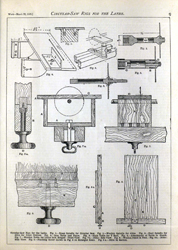
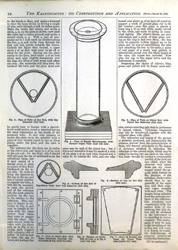
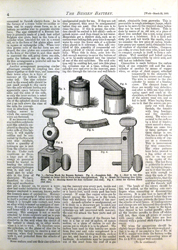
Disclaimer: Articles in Work: The Illustrated Weekly Journal for Mechanics describe materials and methods that would not be considered safe or advisable today. We are not responsible for the content of these magazines, and cannot take any responsibility for anyone attempting projects or procedures described therein.
The first issue of Work was published on March 23rd, 1889. The goal of this project is to release digital copies of the individual issues starting on the same date in 2012, effectively republishing the materials 123 years to the day from their original release.
The original printing was on thin, inexpensive paper. There are many cases of uneven inking and bleed-through from the page behind. Our copies of Work come from bound library volumes of these issues and are subject to unfavorable trimming, missing covers, etc. Please bear with us if a margin is clipped too close, or a few words are unreadable. To minimize harm to these fragile volumes, we've undertaken the task of scanning the books ourselves. We would like to thank James Vasile and Karl Fogel for their help in supplying us with a book scanner and generally enabling this project to get off the ground.
The original content is out of copyright, however, our scans and processing are not. You are welcome to download, print, and pretty much do what you want with the scan for your own personal purposes. Feel free to post a link or a copy on your blog or website. All we ask is a link back to the original project and this blog. We are not giving permission for commercial downloads or reprinting at this time.
 Joel's Blog
Joel's Blog Built-It Blog
Built-It Blog Video Roundup
Video Roundup Classes & Events
Classes & Events Work Magazine
Work Magazine













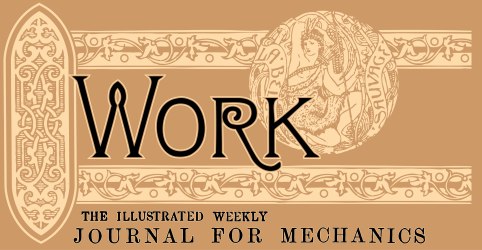
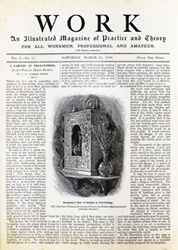



BTW, this style of writing might be more inclusive of class than its contemporaries, but it certainly isn't inclusive of women. But bit by bit, society progresses.
I didn’t read the whole article above so I apologize if the following is redundant. You may have already tried all of the following suggestions, but if not…
Have you tried putting a piece of black paper behind the page when scanning? You can try a smooth textured piece as well a more course textured piece of paper. You might try this as a test. Sometimes it will reduce the bleed through quite a bit and possibly make the exposure more uniform. It may also even out the darker area at the bottom of the pages. I would also suggest trying a white sheet of paper to compare the difference with the black sheet. If the white sheet reduces the bleed through as well, then it may improve the overall exposure, but you’ll have to test and see. Of course if the original page is physically darker at the bottom, then that’s another problem.
If the pages are not physically darker at the bottom of the page, then try rotating the page 180 degrees and scanning again to see if this decreases the darkness at the bottom of the page. This assumes that you can rotate the same page 180 degrees. Of course, if you’ve been rotating the book to copy the next page and it puts the top of the next page where the bottom of the previous page was on the glass scanner plate, then rotating won’t make a difference since your scans currently show only the bottom of the pages darker. Just some thoughts, which may or may not improve the scans, but may be worth trying.
We tried most of these things - The printing is uneven, the paper is unevenly discolored, the paper is very thin. All in all however I think Tim did a great job on the scanning and the results are eminently readable - if a little on the large file size.
joel
Citing a study by Max Weisbuch in the same issue, "The Subtle Transmission of Race Bias via Televised Nonverbal Behavior," Dovidio explains how "As social animals, humans strive to establish a sense of shared reality with others; consensual understanding has the psychological benefit of reducing uncertainty and social anxiety, as well as the practical consequence of enhancing coordination. Because of the primacy, efficiency, and immediacy of nonverbal communication, nonverbal signals can elicit similar responses. People spontaneously mimic the nonverbal behaviors of others. From the social tuning perspective, the impact is deeper than behavioral mirroring: People also adopt the views that the other person is perceived to hold, particularly when there is an affiliative bond with the other person." Concluding, Dovidio observes that "the research of Weisbuch et al. suggests that nonverbal signals of ingroup members toward outgroup members can have a profound impact on ... Americans’ biased behavior—one that occurs largely without awareness. The influence of nonverbal ...evades the normal strategies for inhibiting overt manifestations of bias and can be communicated widely in unspoken ways to have broad impact on intergroup relations.
Thus when panels are convened, filled with persons on only one gender or race, an unconscious message is sent, and received. No doubt this will continue until participants, venders, and even presenters make their feelings known to those organizations and media sources responsible.
Keep it up, just love the old style writing and of course the illustrations.
KW
ps your website does NOT RECONIZE www.thewoodbutcher.eu